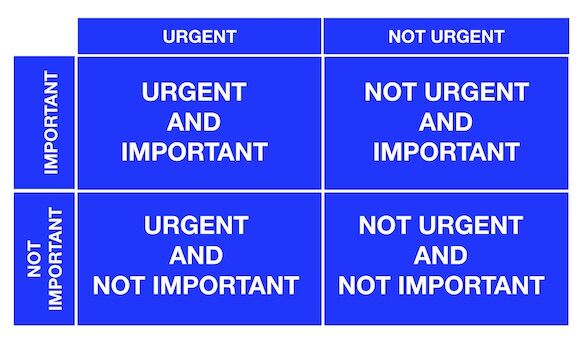Most of our day is spent working on the day-to-day. That is, most of us are pretty good at organizing a to-do list and prioritizing what needs to get done today. We work hard. We’re efficient.
Trouble is, as urgent as many short-term “must dos” are, they rarely include engaging in anything that is innovative or strategic. Our day-to-day typically doesn’t move the needle significantly. Read more: “Are your work habits helping or hurting you??” and, “Top Ten Time Management Tips.”
So how do we accomplish the really important, big picture things?
Over 30 years ago, Stephen Covey wrote The 7 Habits of Highly Effective People. In “Habit 3, Put First Things First,” Covey made use of the “Eisenhower Matrix,” a four quadrant approach to assessing and scheduling your activities according to what is most important, most urgent, and most meaningful.
According to Maren Perry, president of Arden Coaching, The Eisenhower time management matrix remains a surprisingly powerful tool. “The ability to work on the ‘right things’ is an indicator of success. Most people simply don’t take the time to consider the different activities they engage in during the course of their work, or act on the distinctions between things that are urgent — or not — and truly important — or not.”
Map Out Your Four Quadrants
 Consider the work you must do and the work you’d like to do over the course of the next 12 months. Use a shorter timeframe if 12 months seems too daunting or complicated.
Consider the work you must do and the work you’d like to do over the course of the next 12 months. Use a shorter timeframe if 12 months seems too daunting or complicated.
1. First, write down the various activities you engage in, and place each activity in its appropriate quadrant, considering the urgency you feel to get them accomplished, and their actual importance.
For example, working on deadline-driven monthly reports and dealing with an unanticipated crisis would go in Quadrant One, “Urgent and Important.” Developing a new opportunity, building a business relationship, or working on a strategic plan would be placed in Quadrant Two, “Not Urgent/Important.” Certain seemingly necessary meetings and phone calls, and some routine activities go in Quadrant Three, “Urgent/Not Important.” Lastly, let’s admit it, we all spend some time doing things that fall in Quadrant Four, “Not Urgent/Not Important.” This includes, busywork, checking on social media, and other unnecessary time wasters.
2. Estimate the amount of time you spend engaged in the activities you’ve listed in each of the Quadrants.
Be honest with yourself; no one but you needs to see this. Percentages tend to work well, but use hours in a week or month if that works better for you. What do you see? If you are like most, you’ll find that the majority of your time is spent on “urgent” work — Important as well as Not Important — and very little time is spent in Quadrant Two, Not Urgent/Important.
The problem is, Quadrant Two is where the really big, important things happen. Because they are generally not urgent, we push them off to deal with what’s on our desk at the moment. If something is truly significant and important, how do we get to them?
3. Now, begin to make the change you most likely need the most — spend more of your time working on items in Quadrant Two!
According to the Eisenhower Matrix model, the best way to address items in Quadrant Two is to schedule them. Stephen Covey said, “The key is not to prioritize what’s on your schedule, but to schedule your priorities.”
How to Schedule the Important Things
Perry agrees, “Put it on your calendar! For example, if Anthony says that building a relationship with a new technology development company could increase sales 40% in the next two years, but his calendar shows little time actually spent on that effort, then the reality is that it’s mostly talk. He’s ignoring his Quadrant Two and probably hurting his career prospects as well.”
Dedicate and schedule time in your calendar now. Add periods of time in your calendar to work on Quadrant Two efforts for the coming year, the quarter — or, at the very least, the month.
Perry suggests that you schedule the time in your calendar first and promise yourself not to cancel. “If something comes up, moving your scheduled block of time within the week is ok, but do not cancel. It will be tempting, but don’t give up on that block of time. I think you’ll find it energizing to see what shifts occur after spending that time on Quadrant Two work, even for just a month!”
Work on your time management matrix and reflect on its results. Then, get to work — working on the “right” things.
However, it’s difficult to find the time and see the forest through the trees. Read more: “Never Enough Time.” The fact is that most of us are not good at self-assessment. “We struggle to see the potholes in our own path,” notes Perry. “Coaching can help tremendously to clarify your current behaviors, identify areas for improvement, and develop a specific plan of action to create meaningful and lasting change.”
To learn more about how executive coaching can help you work on the right things and become a stronger leader, contact Arden Coaching at info@ardencoaching.com or 646.684.3777.
